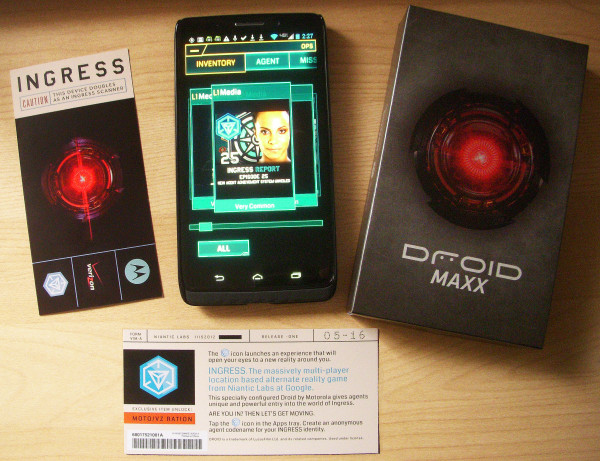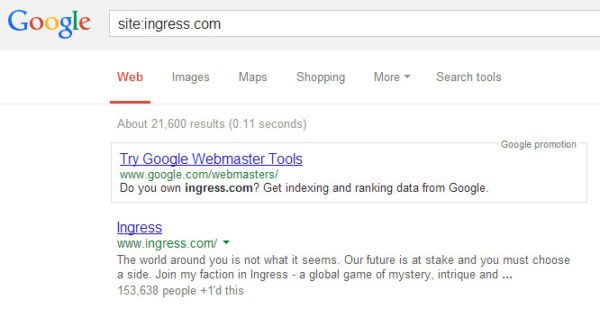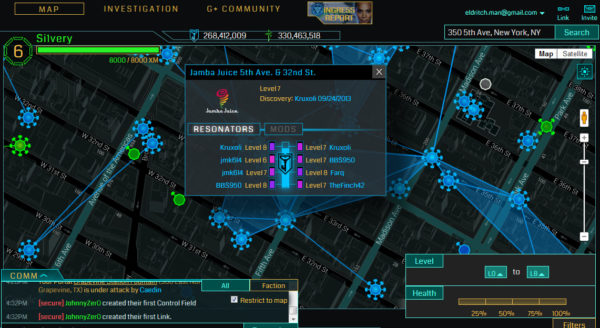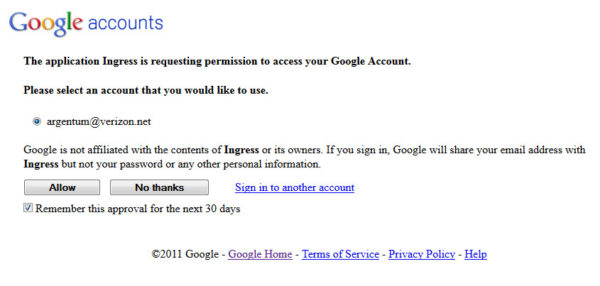Ingress: Is Google’s AR Game A Stealth Local Data Effort?
I recently got a new Android phone and found a little card in the box advertising Ingress, the “massively multi-player location-based alternate reality game from Niantic Labs at Google.” Ingress had slipped past my notice despite Greg Sterling’s mention of it nearly a year ago. Yet, here it was, already preloaded as an app in […]
I recently got a new Android phone and found a little card in the box advertising Ingress, the “massively multi-player location-based alternate reality game from Niantic Labs at Google.”
Ingress had slipped past my notice despite Greg Sterling’s mention of it nearly a year ago. Yet, here it was, already preloaded as an app in my phone, ready to go. The video game is still in beta, but the invite has apparently been expanded to new Droid Maxx owners.

Ingress is preloaded on Droid MAXX phones
Ingress is a skunk works project that emerged from Google Earth as a pet project of John Hanke, VP Product, Niantic Labs at Google (former founder/CEO of Keyhole, Inc. purchased by Google in 2004, now Google Earth). Hanke had long wished to create a multiplayer game based on Google Earth components, and Larry Page allowed him to set it up with greater independence, start-up style, under Niantic Labs.
I’d intended to just dabble with the game a bit, but found it fantastically addictive once I got into it! The concept is that the Earth has a new phenomenon occurring — a sort of energy called Exotic Matter (XM) which has begun to appear in conjunction with some sort of mysterious, alien technology called Portals, which seem to be just a side-step dimension away from our everyday reality. These Portal devices are to be found at publicly-accessible locations such as at monuments, signs, statues, fountains and other places.
The game requires you to choose a “Faction” upon beginning. There are “The Enlightened,” who have embraced the new alien technology and believe it was intended to help jump-start the advancement of the human race. Alternatively, there are those who are concerned that the technology will be used to control the human race and are actively fighting against it, called “The Resistance.”
The goal of the game is one of territory — each faction attempts to take control of Portals and then connect them together in order to create virtual boundaries around areas in the real world. These areas (or “fields”) are then generally protective or friendly for whichever faction created them. Once created, the opposition works to break them, wresting control of the portal over to their own purposes.
What you come to realize after a little while is that Portals are frequently located at popular local spaces. Parks, signs, monuments, churches, post offices, sculptures, fountains and other landmarks — all of these are places where you may find or establish the Portals.
Playing the game requires large quantities of time and some effort as well — one can only hack a Portal for weapons and implements every so often, and it seems to help to visit larger quantities of Portals to collect XM and implements for building more Portals or attacking opposition Portals. So, it’s easiest to hack Portals that happen to be in places one frequents regularly.
Ingress As PlaceRank Local Search Signal?
In local search rankings, Google has used PlaceRank as part of the overall algorithm — PlaceRank is the concept that locations may have popularity in and of themselves, distinct from the things found at those locations, such as businesses. There are all sorts of signals that might indicate a location’s popularity: the number of photos and videos associated with the location; how frequently a location is searched or mentioned via social media; or, how often people request driving directions to it.
Ingress would certainly provide a rich source of data about locations in addition to the many other signals Google is already using in local search. Players can upload photos when they submit a place for consideration as a new Portal. More importantly, perhaps, the data around players’ visits to Portals could provide a strong signal for the relative popularity of locations — i.e., PlaceRank.
Ingress As Check-In Ranking Factor?
I’ve written before of the high likelihood that Google could be using check-in services as a local ranking factor. Social services featuring check-ins, such as Foursquare and Facebook, provide yet another source of data for the relative popularity of places.
While Google’s earlier efforts at similar check-in services (such as Latitude, and perhaps Hotpot) have been largely abortive, Ingress is pretty much a giant check-in service itself. It’s a check-in service on speed. Where Foursquare’s game playing aspect is pretty low-key (not to mention they seem to be moving away from game play features), Ingress is a check-in service that has embraced competition fully.
You’re compelled to explore your environment, venturing out to find and visit more places to conquer more territory, and you’re checking into locations all along the way. It’s an incentivized check-in service — you’re driven to send Ingress information about where you are in order to get further ahead in the game. In retrospect, Foursquare may have made a strategic error in stepping back from its gaming component.
It’s not at all clear if Ingress is really sending location data back to Google local search properties. On the service, you can do a site-colon search and see that Google has indexed over twenty thousand Ingress.com pages:

Ingress Pages Indexed in Google Search Results
Of the Ingress pages indexed, a majority of them are about particular locations, as you can see from the latitude and longitude values in the URL query strings:
https://www.ingress.com/intel?latE6=51928649&lngE6=4497781&z=15
However, the pages display nothing unless you’re logged into Ingress with your username, so the cached version of the pages in Google’s index would seem very poor as a data source. It’s possible that the mere existence of the page URLs containing geo coordinates in the query strings could be a signal in and of themselves — technically speaking, just mentioning geo coordinates could be a sort of Local Citation. But, one supposes that Ingress would be far more likely to be delivering data to Google on the back-end via direct data feeds, if they were providing information for local ranking purposes.
If you’re logged in to the Ingress website, you can view rich maps showing the progress in territory-building of the two factions, along with information about the locations of various Portals:

Ingress Map – Chicago
Marketing Opportunities For Businesses
Regardless of whether Ingress data might be intended to power local search in some way, the game is now already something of a powerful marketing channel, and it’s poised to potentially become even more so.
The game reportedly had half a million players worldwide as of May; but, I’d project that it could be in the range of 1.5 to 2 million now and undoubtedly growing. Ingress already has sponsors lined up for this audience. As Greg reported last year, Ingress has one or two sponsors advertising within the medium. The one I’ve seen regularly in the game is Jamba Juice.
Ingress apparently has seeded all of Jamba Juice’s approximately 800 store locations into the game as Portals. Unless you’ve played the game, you might not get the implication — this game is actually driving foot-traffic to brick-and-mortar stores!
Jamba Juice is a perfect match for this sort of promotion, too. Since the game is very physically active — one pretty much must get out and walk to be within close enough proximity of any of the Portals in order to act upon them — you can easily work up a considerable thirst.

Jamba Juice screen in Irving, Texas – Ingress Mobile Phone Game
Unlike many other video games, Ingress encourages one to exercise by walking, running or biking in order to cover considerable territory — it even displays statistics on how much distance you’ve gone in kilometers.
I’ve actually reached the point of taking my mobile phone with me while running in the park so I can get more points for checking into Portals, recharging them, upgrading them, and linking them to one another. It’s really added another fun dimension to my workout routine and pushed me to go greater distances than previously!
Ingress Can Drive Branding & Foot Traffic
Here in Texas in the warm months, which is the majority of the year, thirst is not to be underestimated. You can imagine that Starbucks or 7-Eleven stores would also be a perfect match for this type of promotion, too. Not only could this be brand-building, but it increases awareness of store locations as it also drives real traffic to the stores.
Just imagine if you could convert all the millions of users of Minecraft or EverQuest into visitors to your stores? Ingress is doing exactly that. I’m not sure if there is any other type of game driving people to visit stores, unless you count something like McDonald’s Monopoly games (which are pretty impressively effective, too).

A Jamba Juice Location in Manhattan – Ingress Game Screen
Are other stores unofficially promoting themselves within Ingress, too? I’ve visited quite a few locations in shopping centers, such as statues, clock towers and fountains. But, there are also very specific Portals created from such things as a concrete lion statue outside of a Chinese restaurant, and a very uniquely iconic sign for a diner I found in Austin (the Hyde Park Bar & Grille’s fork sign).
It’s not at all clear if these were purposefully created by shop owners to try to attract attention, or if they were just locations proposed by Ingress users who frequent those places.

The Hyde Park Bar & Grille’s iconic fork-shaped sign is an Ingress Portal.
(Note Ingress also has a little thumbs-up shaped approval button feature similar to Facebook.)
Obviously, only some types of businesses would directly derive value from this sort of promotion, and some types of business locations might consider the added non-customer foot and car traffic to be highly undesirable. (Since Ingress is not widely known yet, there are reported instances of players being questioned by police or even arrested for suspicious behavior. Imagine if police overheard your app declaring that you’d “targeted” a location, that you’re “in range,” and that you’re “successfully hacking”! Difficult to explain. Seemingly sinister.)
What may be an even greater marketing factor in all this is the potential for Ingress to further break out and expand the channels of consumers and data sources. If the Niantic Labs folks open their game platform up for other developers to create their own apps, as they’ve mentioned it being a possibility, this could be nearly as disruptive as the advent of Google Maps was.
Not only could others create augmented reality games, but you could have artists generating virtual reality art pieces that could be viewed at specific locations, or it could be used to track and chart one’s travel, or it could be used by repair companies to check the locations of their on-site repairmen. There are numerous possibilities, and providing an open platform blasts open this potential.
Is Google Using This Data? If So, What For?
Is Google actually using data from Ingress to feed into local search algorithms? When you attempt to log in to the Ingress website, you must use a Google account, and this message pops up stating that “Google is not affiliated with the contents of Ingress or its owners.”
This seems a glaring error (and one that would surely give officials of the European Union some pause, considering its heavy scrutiny of Google’s personal data handling practices). Is this to signify that data is not traded back to the mother ship that spawned Ingress? Difficult to believe, that one.

Ingress Screen Incorrectly Conveys It Is Not Affiliated With Google
There’s something else a bit odd, as well. The places where the little XM energy dots tend to appear also seem to be places where people frequent. Is it places where Google has detected the location and presence of Android phones on a frequent basis?
Niantic Labs could have easily had the bits of XM appear randomly throughout the landscape — and there’s undoubtedly a randomization factor involved. But, there’s also some evidence that the signal of Android phones could be involved in determining where XM randomly appears.
XM doesn’t only randomly occur in the environment — it propagates frequently and abundantly around Portals, of course. But, it’s the other places where it occurs that seem indicative that the locations are not purely randomized but informed by one or more other data sources.
The XM occurs with particular density around Verizon Wireless store locations, as well as more densely around shopping centers, libraries, and other public places — and is randomly scattered through residential neighborhoods in little bits. Could Niantic Labs have initially seeded the game with data harvested from Android usage in some way? Or, did they merely seed-in the locations of Verizon Wireless stores, since they know there are likely to be numbers of Android users in those places?
I wouldn’t even be conjecturing such an idea if it weren’t for the fact that there have been consistent reports that people have found Androids to be transmitting smartphone users’ locations back to Google.
Of course, you must also figure that the Android phone location data could be completely sufficient in and of itself as a data source for feeding the PlaceRank aspects of the local ranking algorithms. Other than the photos, Google maybe wouldn’t need Ingress’s comparatively small fraction of location data, and I cannot find clear indication that Google has made use of the Portal location photos anywhere outside of Ingress. Yet. But, why wouldn’t they?
Final Thoughts
Of course, it’s quite easy for those in the search engine optimization profession to assume there are hidden motives in every little thing that Google does. But this augmented reality game is very much a game-changer in many ways, regardless of whether users’ data is being collected to help feed local ranking algorithms or not.
Ingress is rapidly growing into a potentially major marketing channel with a valuable audience of users, and the gaming component has the unique ability to drive foot traffic to stores and shopping centers in the real world. For local marketers, this is now a channel to seriously consider for some types of businesses.
If Ingress is not feeding users’ location data on the back-end into local search algorithms, the simple function of it driving foot traffic to specific locations could easily have an indirect effect upon all the other local search ranking factors that are used for determining relative location popularity.
Ingress is still only in beta mode and only open via invites at this time; but, it must surely be inching near to emerging from beta status, and this will expand usership by some significant degree. Also, Ingress is reportedly going to be released on iOS for iPhone users in 2014, and I’d predict this could rapidly double the number of users involved in the game within a very short timeframe.
As it approaches these tipping points, it’s going to be worthwhile to watch; and for some businesses, it’s already likely worthwhile to find ways to engage with the medium.
Contributing authors are invited to create content for Search Engine Land and are chosen for their expertise and contribution to the search community. Our contributors work under the oversight of the editorial staff and contributions are checked for quality and relevance to our readers. The opinions they express are their own.
Related stories